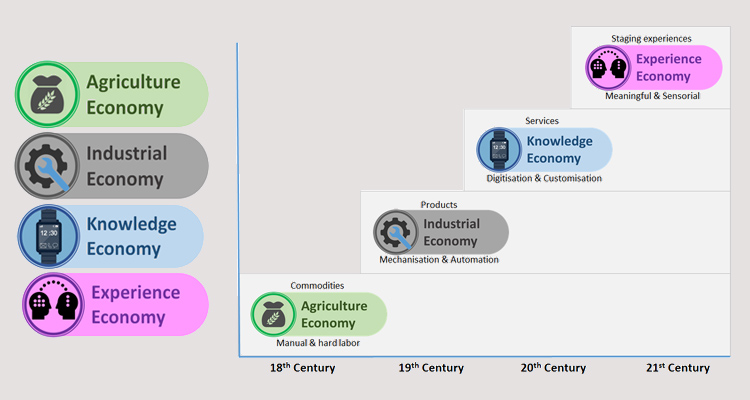
Design for the Experience Economy
By : Pankaj Jhunja

A'dosa' bought from a street-side stall at Rs 30, becomes a Rs 60 meal in a multi-cuisine Udipi and a Rs 180 engagement at a South Indian theme restaurant where the ambience, the smells, the dress of the serving staff, the music etc. all enhance the experience during consumption.
People are willing to pay differentially when they move from accessing a product to being immersed in an experience – with the basic commodity being consumed remaining nearly the same, but getting layered through a sensorial and emotional engagement to magnify the experience.
Strong indicators are becoming evident in today's time –while seemingly unconnected these are driving the increasing challenges being faced by businesses:
The ability to differentiate goods and services is getting more and more difficult – with what was a differentiator till yesterday becoming a hygiene factor. In this very crowded and competitive landscape it is becoming difficult for companies to stand out with unique value propositions.
With increasing disposable incomes coupled to impulse consumption (also driven by one's ability to spend without feeling guilty) - the customer is willing to pay a premium if they connect with the value proposition beyond the function.
Technology is creating newer opportunities of interfacing and transacting for companies to engage with their customers – digitisation, virtual &augmented reality etc.
People are gradually preferring topay for outcomes –not necessarily the means – thereby influencing both the ownership as well as consumption models for example the Ola and Uber models.
An asset owner (vehicle, room, knowledge, capital) is looking at opportunities to link up via enabling platforms to monetise the asset – thereby throwing conventional business models and competitive advantages in disarray. E.g. Airbnb, Crowd funding, Uber etc.
With these changes we are beginning to see the green shoots of the 'Experience Economy', in which products and services will become a minimum offering, and people will pay for their experiences. This then creates an opportunity for Design to help stage these experiences by bringing Design Thinking to the fore as a methodology – and used not only by Designers but every function/process including strategy, route to market, service etc. This will also drive companies to reconsider what their basic value proposition to the customer is – and those that do not ask this question and reaffirm its connect with evolving consumer needs / consumption trends – may perish. A bicycle maker has a choice to connect with the mobility needs, the wellness needs and/or the entertainment requirements of their consumers and package and pitch accordingly.
Companies have started exploring different routes to create these experiences and hence opportunities to premiumise their offerings - from storytelling to gamification to personalisation and mass customisation –all of which is co-created with the consumer for the highest gratification.
Not only do companies need to take this on board on the offerings they take to market, but more importantly they need to make structural changes at the backend that will facilitate it. These experiences will be created through the convergence of multiple design, development and business disciplines working seamlessly across domains with people who have this sensitivity and ability. Boundaries between hardware, software and content will need to be diffused to create this unified interface. Companies will need to create a working environment (organisation, process, decision making, governance etc.) that allows this to happen.
Institutes of learning need to take this onboard to allow cross pollination of skills and sensibilities rather than developing product designers, graphic designers, interior designers, engineering designers, marketing professionals etc. Education would need to move from teaching basic skills, processes and tools to students learning to be more compassionate, caring and empathetic.
There is a great opportunity and need for Indian Design to take this on board – in order to address the needs of the aware, aspirational, demanding and diverse consumer and create strong contextual (may be local) offerings.
This will need to reflect in policy, be it the National Design policy, the Education policy, the revenue guidelines on taxation (today experience design is clubbed with services) to create a framework that catalyses the growth in this direction.
As early as 2004 when speaking to New York times after taking over as head of General Motors, Bob Lutz defined their business as:
Its more right brain…..I see us being in the art business. Art, entertainment and mobile sculpture, which coincidentally also happens to provide transportation.
Pankaj Jhunja
General Manager Design
Tata Motors
